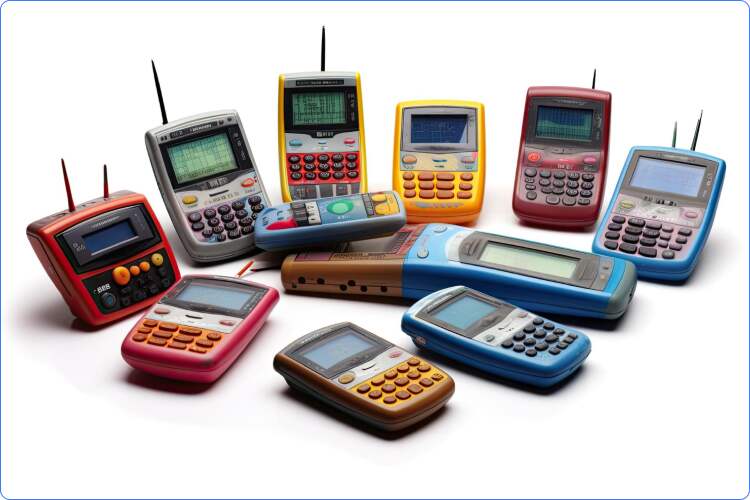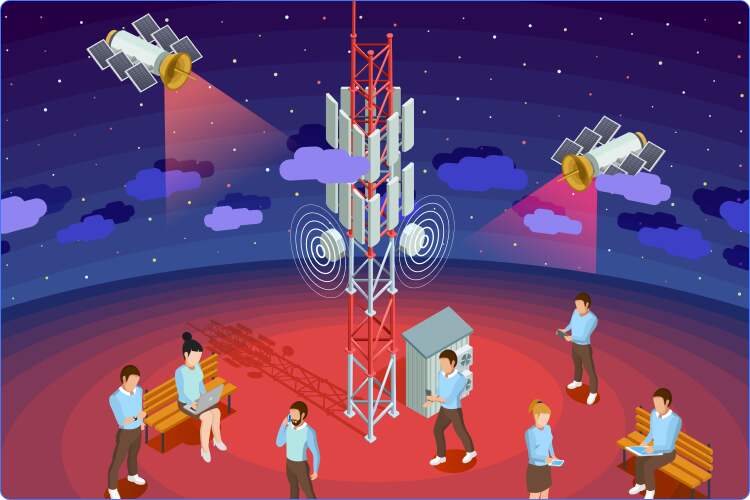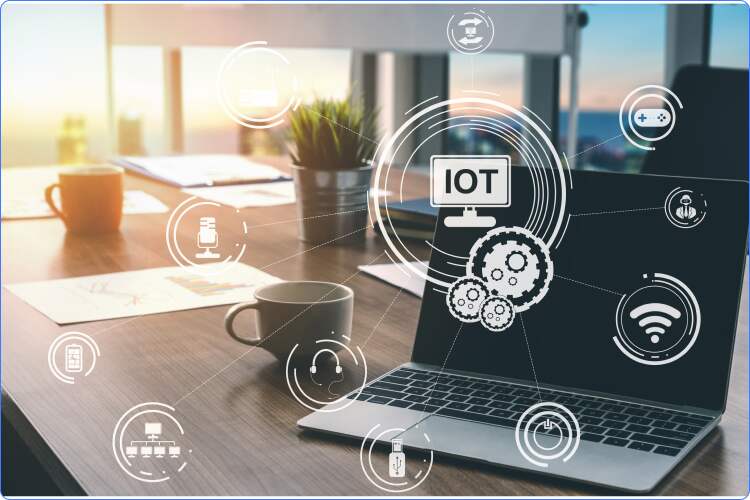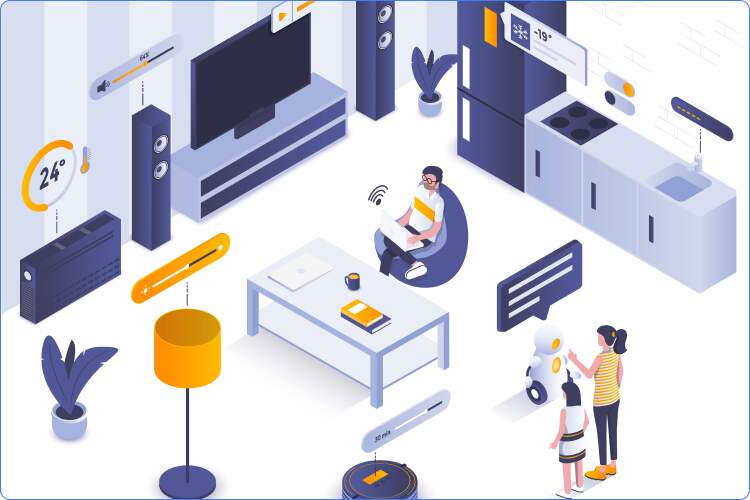
Did you know that out of nearly 8 billion people in the world, almost 5.35 billion (66% of the world’s population) of them have access to the Internet? This figure is expected to reach 7.9 billion by the end of 2029, marking a significant milestone in connectivity (Source- Statista). The telecommunication industry, which is the backbone of this connectivity, has undergone a seismic transformation in recent years. But what is yet to come? The advent of game-changing technologies like 5G, IoT, Edge, AI, and several others ascertains that the future of telecom industry will be a journey of exciting possibilities.
Before we look at the emerging trends that depict the telecom industry’s future, let’s take a look at some of the important milestones that led to the evolution of telecom.
History of Telecommunication – A Series of Transformations

The way telecommunications started and evolved is quite interesting.
- In 1837, Samuel Morse invented the telegraph. This was the start of long-distance communication done via electrical signals.
- In 1876, the invention of the telephone by Alexander Graham Bell took place. This was a breakthrough that enabled real-time voice communication over long distances.
- In the late 19th Century, the establishment of PSTN i.e. Public Switched Telephone Network took place that helped connect individuals and businesses across borders.
- Then in 1946, the first commercial mobile phone service by Bell Labs was launched. While early mobile phones were bulky hardware, they marked the beginning of mobile telecommunications paving the way for more advanced forms of mobile communication.
- In the 1990s, the GSM i.e. Global System for Mobile Communication came into existence. This led to the introduction of mobile data services such as SMS and mobile internet access.
- The late 20th century witnessed the birth and proliferation of ‘The Internet’ along with digital communication technologies. By now, people have started communicating through Email, Instant Messaging, and VoIP services.
- From the 2000s till the present, the deployment of 3G, 4G, and 5G networks fortified mobile communication in terms of speed, capacity, and reliability. With this, the industry ushered into an era of mobile broadband, IoT applications, and connected devices.
- The 21st century also witnessed the emergence of OTT services which disrupted the traditional telecommunication models and provided consumers with unimaginable choice and flexibility.
We just looked upon some of the major milestones in the telecommunication industry, with each advancement leading to increased connectivity, innovation, and transformation. These advancements do not end here; rather, there are continuous ongoing developments.
The Current State of the Telecom Industry
In the past, carriers used to be the leaders as they built networks that enabled us to connect to the internet almost everywhere. However, with new digital technologies like internet calling and instant messaging, carriers lost their significance. This happened because carriers didn’t adapt to this change and focused mainly on maintaining their existing infrastructure. This negligence created an opportunity for other companies to take over.

Today, we are in an era where we have computers, the internet, smartphones, and social media. Customer expectations are changing; people today want more personalized and convenient ways to communicate. And, as technology keeps getting better, we are becoming even more connected.
This is where telecoms still have the opportunity to change. Rather than just being connectivity providers, telcos can become Digital Leaders. They can expand their services beyond connectivity and provide customers with a comprehensive and seamless digital experience. For instance, the split of Vodafone into networks and digital services is how some carriers are striving to regain their lost position in the industry.
Moving ahead, we will discuss the top emerging telecommunication technologies that are going to define the future of telecom industry.
Emerging Trends Transforming the Telecom Landscape
5G Revolution

The year 2023 brought one of the biggest innovations of the time – the super-fast internet called 5G. ‘Fast’ may not be the perfect term when we talk about the speed at which 5G connects devices, machines, and gadgets. And that’s not all, 5G is expected to to connect almost anything to the Internet including the future things we don’t have yet. Innovations like Metaverse and IoT require fast and reliable internet connections. This is where the importance of telecom providers comes into the picture as they provide the fast and safe connections needed for all innovations.
Besides 5G, telecom companies also need to get ready for the 6G. The sixth-generation technology standard for cellular networks will be faster and more reliable, so the telecom carriers’ efforts to build, maintain, and upgrade their networks and traffic management to support 5G networks will be super important.
Internet of Things

IoT is all about connecting everyday things. This smart technology is meant to make our lives easier than ever before. But who ensures a seamless experience every single time while we use all the smart devices together? It’s the telecom companies that set up the infrastructure needed for IoT. From connectivity to network management, telecom providers play a critical role by providing the essential infrastructure and services that power these connected devices.
Besides this, telecoms can further solidify their role in the IoT landscape by focusing on these key areas:
- Develop partnerships to create comprehensive IoT solutions. Telecoms can collaborate with device manufacturers, software developers, and industry players.
- Investment in research and development is another area that can lead to innovation. With this, telecoms can explore new technologies like Network Slicing that cater to specific IoT applications.
- Telecoms can focus on developing robust security solutions to protect data transmissions and ensure the privacy of the collected information by connected devices.
Artificial Intelligence

AI is all the buzz these days and holds immense value for the telecom industry. From predicting consumer behavior to spot issues with the networks and fixing them on their own, as well as keeping scammers at bay, AI can improve the overall operations of telecom companies.
Have you heard about a new kind of AI called Generative AI? You must know that Gen-AI can be quite useful in streamlining customer services such as customer care. This is of great advantage to CSPs i.e. Communication Service Providers as they can manage traffic more efficiently and even fortify security.
Gen-AI is capable of creating smart bots that significantly transform customer experiences. By providing quick and efficient responses to regular customer queries, Gen-AI reduces wait times and improves customer experiences.
Quantum

According to a survey by Capgemini, over 40 percent of organizations in the combined telecom and public sector are working on or are planning to work on quantum technologies. A significant percentage of telecom executives believe that quantum can be a real game changer in the next few years. Quantum tech is a super powerful technology that can be used to create super secure networks and thus provide ultra-secure communication when it comes to customer data and internet traffic.
But there’s a catch.
While quantum can do all the amazing stuff, it can also create opportunities for cyber threat actors to break into encrypted data. Therefore, telecom companies need to be careful while using quantum tools. Besides security, quantum can be a powerful tool to speed up online communication in the future. However, at present quantum is still not being widely used. To move from just talking about this technology to using it, telecom companies will need experts to understand quantum in a better way.
xRAN

The traditional approach to building and setting up mobile networks generally involves buying everything from one company. This can be expensive and limits the choices also. Nowadays, alternative ways that can make things more flexible for telcos are emerging. With these new approaches, telcos need to spend less money on buying equipment and also get their services up and running much faster. One of these new approaches is xRAN.
Let’s discuss it in more detail.
- Open RAN: while still under development, ORAN is the concept where different companies’ equipment works together smoothly.
- Centralized RAN: In CRAN, multiple mobile sites share the same equipment for their work.
- Virtualized RAN: VRAN makes the networks more flexible and adaptable with the use of software.
Out of the above 3, ORAN is the one that telecom executives are interested in using. These new ways of setting up mobile networks can help telcos in several ways:
- Choose different suppliers for different needs
- Less risky to try out new technology
- Create customized solutions that work better for telcos.
To make this work, telcos will need experts with skills in data engineering, cloud, product management, and DevOps.
Edge Computing
With the increase in real-time applications and the need for reduced latency, edge computing, which processes data closer to its source, will gain momentum. Edge computing capabilities will enable faster data processing and analysis at the network edge, which will be extremely beneficial for real-time applications such as autonomous vehicles. Being infrastructure and connectivity providers, telcos can partner with tech companies and invest in edge data centers to offer advanced solutions for various industries.
Predictions for the Future of Telecom Industry
The Rise of 6G

While 5G has amazed each one of us, 6G is certainly going to blow our minds. With ultra-fast downloading speeds and zero lag responsiveness, the 6th generation of cellular network technology will be hundreds of times faster than our current 5G networks. From immersive virtual realities, and smart cities to autonomous systems and innovations in healthcare, the advent of 6G is expected to bring groundbreaking advancements in various sectors. Here’s a comparison of various aspects of 6G with its predecessor 5G:
- Data Rate: While 5G offers a downloading speed of 100-1000 Mbps, the 6G technology is projected to take it to a remarkable 1 TBPS.
- End-to-End Latency: 6G is expected to reduce end-to-end latency to 1 millisecond compared to 10 milliseconds of 5G.
- Network Mobility Support: 6G demonstrated an outstanding speed of up to 1000 km/hr while 5G offers 500 km/hr.
AI is Here to Stay and Transform
While we have discussed the current state of AI technology, it is predictable that AI is here to stay for the long haul. While the use of AI in the telecom industry is slowly but surely growing, it is expected to transform the telecom industry in numerous ways. According to a report by Experian, companies implementing AI for telecom fraud detection have witnessed success rates as high as 90% in real-time fraud identification.

According to recent research from Tractica, AI is poised to generate nearly $11 billion annually for telecom companies by 2025. Statistics reveal that “65% of customers express higher satisfaction in AI-powered interactions”. It has also been found that “55% of companies plan to introduce new AI-powered services in 2025, indicating a trend toward diversification and exploring novel revenue streams”.
The Internet of Things Will Enter a New Era
According to Wikipedia, IoT is described as devices with sensors, processing ability, software, and other technologies that connect and exchange data with other devices and systems over the Internet or other communications networks. Projections suggest that by 2025, the number of IoT devices in use worldwide will reach a staggering 38.6 billion. Driven by the convergence of powerful technologies like 6G and Artificial Intelligence, the Internet of Things is poised to enter an era where the physical and digital worlds will become even more intricately connected.

With billions of devices connected seamlessly, we can expect AI to analyze the massive amount of data to optimize performance and identify issues. And with the ultra-fast speeds and low latency of 6G, the real-time communication between devices will be truly intelligent.
Conclusion
Now that we have done the telecom industry analysis, it all boils down to one thing – the future of telecom industry simply depends upon how well the telcos keep up with the emerging trends. While several big changes are happening in the industry, sticking to the same old strategies won’t work anymore. Telecoms need to put constant effort into reforming their operations. They need to invest in new ideas to keep up with the ever-increasing demand. In other words, telecom companies need to embrace innovation, adapt to changing customer needs, and collaborate with other players in the evolving ecosystem.




























